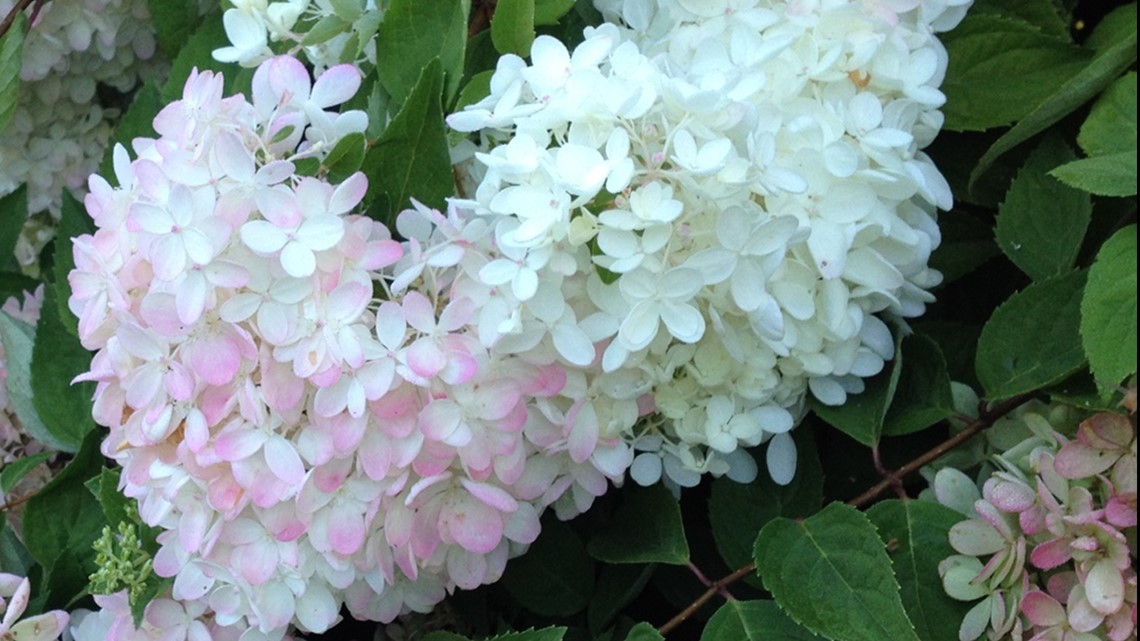SEATTLE — I love Hydrangeas. They’re one of the only shrubs that bloom in the middle of summer when color is needed the most, and better yet, they even bloom well in shade. In fact most kinds of Hydrangea do best if they're protected from hot afternoon sun. Give them well drained soil and a bright location, and about the only maintenance required is pruning in spring.
What to look for when you buy
When you buy a Hydrangea, check the label to see what basic kind it is. The traditional ones with the pom-pom or lace cap flowers (Hydrangea macrophylla) usually bloom only on last seasons growth. That's important to know because if they get too tall and you cut them back hard in spring (the best time to prune Hydrangeas) you won't get any flowers for the rest of the year.


The best way to prune these kind of hydrangeas is to symmetrically remove about 1/3 of the canes by cutting them right to the ground or where they come off another cane at the base. On the remaining stems, cut the top growth to a healthy bud just below where last year’s flowers occurred. You’ll get a taller, more elegant looking plant and although you’ll get fewer blooms, the ones you get will be bigger and better than ever. Your Hydrangea will show its appreciation by blooming profusely every summer for years to come.
This is true for oak leaf Hydrangeas as well. There are a few new varieties of pom-pom hydrangea such as ‘Endless Summer’ and ‘Blushing Bride’ that bloom on current season’s growth, but they look and perform better if you prune them as described above as well.
There are, however, hydrangeas that blossom exclusively on current season growth and therefore, bloom beautifully even if you cut them back practically to the ground in spring. Hydrangea arborescens (smooth Hydrangea) is a native of the eastern United States is hardy to about –30 degrees. Left unpruned, it can reach over 10 feet tall. The most popular variety is ‘Annabelle’ which produces enormous, snow white 12 inch sphere-shaped flowers. A recent introduction, ‘Invincible Spirit’, has the same huge flowers, but the blossoms are pink.
The other kind of Hydrangea that will bloom in summer, even after being cut back hard in spring, is Hydrangea paniculata (hardy hydrangea). Hailing from Japan and China, these sun-loving Hydrangeas are usually grown as trees, but they can also be cut back practically to the ground if need be. The best-known Hydrangea paniculata is ‘Grandiflora’, commonly known as ‘PeeGee’.


Hardy to at least –30 degrees, its capable of reaching 15 feet tall and produces gazillions of 8-inch snowball shaped flowers that start snow white before fading to soft pink. A smaller growing paniculata is ‘Limelight’ which grows only to about 6 feet tall, and features green cone-shaped flowers that turn pink as they age.
Want a Different Color? Change it!
If the flowers on your Hydrangea change color after you bring it home from the nursery it all has to do with the pH of the soil. Hydrangea flowers tend to turn blue in acid soils and turn pink if the soil is sweeter, or more alkaline. It isn’t actually the acidity that causes flowers to change color. Hydrangea color is determined by the availability of aluminum in the soil. In acid soil aluminum is easily absorbed resulting in bluer flowers, while the opposite is true in alkaline soils resulting in pinker flowers. The chemical that is most often used to attain blue Hydrangea flowers is aluminum sulfate. Apply this according to directions on the label monthly starting in February. To achieve pinker flower color, sprinkle 1/2 cup of garden lime per 10 square feet every fall. This is a slow process and can take a couple of years to work.
How to Dry Hydrangeas
The traditional method to dry hydrangea flowers is to hang them upside down in a dry room. If you cut them at their most colorful, they retain too much moisture and tend to rot in the drying room. If you wait for them to dry on the plant, they’re often too washed out. The best way to dry the flowers is to cut them when the blooms are just beyond their peak, but still have vivid color, and put the stem of each flower in its own shot glass half-full of water. Each stem must be in its own shot glass. They’ll rot if you put a bunch of stems in a vase with the appropriate amount of water. Prop the flowers up in a dark room and don’t refill the shot glass. The flowers usually dry in 2 to 3 weeks. I’ve been using this method for years with great success.
Segment Producer Suzie Wiley. Watch New Day Northwest 11 AM weekdays on KING 5 and streaming live on KING5.com. Contact New Day.

